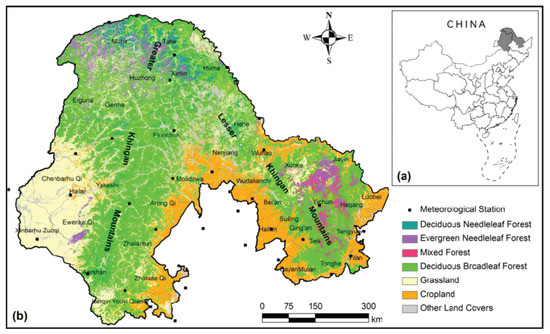-
 Exploring the Potential Applications of the Noninvasive Reporter Gene RUBY in Plant Genetic Transformation
Exploring the Potential Applications of the Noninvasive Reporter Gene RUBY in Plant Genetic Transformation -
 An Overview of Oak Species in Pakistan: Past, Present, and Future Research Perspectives
An Overview of Oak Species in Pakistan: Past, Present, and Future Research Perspectives -
 Tree Species Classification in a Complex Brazilian Tropical Forest Using Hyperspectral and LiDAR Data
Tree Species Classification in a Complex Brazilian Tropical Forest Using Hyperspectral and LiDAR Data -
 One-Step Process for the Fabrication of Hydrophobic and Dimensional Stable Wood Using Functionalized Silica Nanoparticles
One-Step Process for the Fabrication of Hydrophobic and Dimensional Stable Wood Using Functionalized Silica Nanoparticles -
 Disturbance and Succession in Early to Mid-Holocene Northern English Forests: Palaeoecological Evidence for Disturbance of Woodland Ecosystems by Mesolithic Hunter-Gatherers
Disturbance and Succession in Early to Mid-Holocene Northern English Forests: Palaeoecological Evidence for Disturbance of Woodland Ecosystems by Mesolithic Hunter-Gatherers
Journal Description
Forests
Forests
is a peer-reviewed, open access journal of forestry and forest ecology published monthly online by MDPI.
- Open Access— free for readers, with article processing charges (APC) paid by authors or their institutions.
- High Visibility: indexed within Scopus, SCIE (Web of Science), Ei Compendex, GEOBASE, PubAg, AGRIS, PaperChem, and other databases.
- Journal Rank: JCR - Q1 (Forestry) / CiteScore - Q1 (Forestry)
- Rapid Publication: manuscripts are peer-reviewed and a first decision is provided to authors approximately 19 days after submission; acceptance to publication is undertaken in 2.6 days (median values for papers published in this journal in the first half of 2023).
- Recognition of Reviewers: reviewers who provide timely, thorough peer-review reports receive vouchers entitling them to a discount on the APC of their next publication in any MDPI journal, in appreciation of the work done.
- Testimonials: See what our editors and authors say about Forests.
Impact Factor:
2.9 (2022);
5-Year Impact Factor:
3.0 (2022)
Latest Articles
Optimizing Carbon Sequestration in Forest Management Plans Using Advanced Algorithms: A Case Study of Greater Khingan Mountains
Forests 2023, 14(9), 1785; https://doi.org/10.3390/f14091785 (registering DOI) - 01 Sep 2023
Abstract
The Paris Agreement aims to combat climate change by reducing greenhouse gas emissions, with bioenergy identified as a potential solution. However, concerns remain about its impact on carbon stocks and the optimal timing for implementation. To address these challenges, we propose a comprehensive
[...] Read more.
The Paris Agreement aims to combat climate change by reducing greenhouse gas emissions, with bioenergy identified as a potential solution. However, concerns remain about its impact on carbon stocks and the optimal timing for implementation. To address these challenges, we propose a comprehensive multi-objective optimization model for forest management that maximizes carbon sequestration and economic benefits. Our model integrates three key components: (1) a sophisticated carbon-sequestration model encompassing living plants, wood forest products, and soil and microbial carbon uptake, (2) dynamic factors such as forest fires and extreme weather events, and (3) an economic benefits model focused on wood-processing products. We optimized the forest-management strategy over ten years by leveraging the simulated annealing and Karush–Kuhn–Tucker (KKT) algorithms. Through simulations using data from China’s Greater Khingan Mountains region, we explored the optimal logging plans for maximizing carbon sequestration without external factors. Our results revealed that the optimized logging plans significantly enhance carbon sequestration compared to proportionally averaged logging plans. Next, we investigated the impact of external factors on forest management, specifically wildfires and extreme weather events. Our findings demonstrate that wildfires have a more-substantial detrimental effect on the absolute value of carbon sequestration and the extent of improvement achieved through model optimization. At the same time, extreme cold primarily affects the growth rate of carbon sequestration. We employed a linear-weighting approach and the Analytic Hierarchy Process (AHP) to address the trade-offs between carbon sequestration and economic benefits to transform the multi-objective optimization function into a single objective. The results showed that the optimized harvesting schedule can lead to improved economic benefits compared to uniformly harvesting trees. Moreover, the joint optimization approach enabled us to identify optimal solutions that balance carbon sequestration and economic benefits, offering sustainable forest management strategies. Our study provides valuable quantitative insights into forest management strategies that balance carbon sequestration and economic benefits, making it highly relevant for real-world applications.
Full article
(This article belongs to the Special Issue Impacts of Forest Management Practices on Carbon Sequestration and Greenhouse Gas Exchange)
►
Show Figures
Open AccessReview
Responses of Physiological, Morphological and Anatomical Traits to Abiotic Stress in Woody Plants
by
, , , , , , , and
Forests 2023, 14(9), 1784; https://doi.org/10.3390/f14091784 (registering DOI) - 01 Sep 2023
Abstract
Abiotic stresses could have complex and diverse effects on the growth and development of forest trees. In this review, we summarized the responses of morphological, physiological and anatomical traits in woody plants to abiotic stresses, including drought, flood, extreme temperature, salinity, heavy metal,
[...] Read more.
Abiotic stresses could have complex and diverse effects on the growth and development of forest trees. In this review, we summarized the responses of morphological, physiological and anatomical traits in woody plants to abiotic stresses, including drought, flood, extreme temperature, salinity, heavy metal, microplastics and combined stresses, especially from the xylem perspective. Under most abiotic stress, xylem hydraulic conductivity decreases, which is associated with leaf stomatal regulation and the inhibition of aquaporin (AQP) activity. Meanwhile, woody plants regulate the size and morphology of their roots and leaves to balance water absorption and transpiration. The anatomical traits are also altered, such as denser leaf stomata, narrower conduits and thicker cell walls. In addition, different stresses have unique effects, such as flood-induced adventitious roots and aeration tissues, forest fire-induced irreversible xylem damage, low temperature-induced tissue freezing, salt stress-induced hinderance of ion absorption and heavy metal-induced biological toxicity. Under stresses of drought, flooding and heavy metals, woody plants’ growth may occasionally be promoted. The effects of combined stress on the physiological, morphological and anatomical traits of woody plants are not simply additive, with the related mechanism to be further studied, especially in natural or near-natural conditions.
Full article
(This article belongs to the Section Forest Ecophysiology and Biology)
►▼
Show Figures
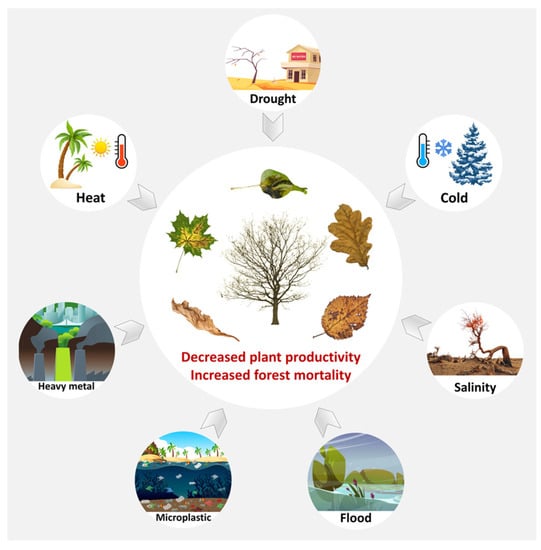
Figure 1
Open AccessArticle
The Impact of Natural Regeneration of Phoebe bournei in Anfu County, Jiangxi Province, on Community Diversity and Soil Nutrient Characteristics
Forests 2023, 14(9), 1783; https://doi.org/10.3390/f14091783 (registering DOI) - 01 Sep 2023
Abstract
The ecological process of natural regeneration in forests is achieved by altering the relationship between community diversity and abiotic factors, thereby influencing the structure and functioning of ecosystems. Phoebe bournei is a unique and endangered tree species in China, and due to the
[...] Read more.
The ecological process of natural regeneration in forests is achieved by altering the relationship between community diversity and abiotic factors, thereby influencing the structure and functioning of ecosystems. Phoebe bournei is a unique and endangered tree species in China, and due to the rarity of P. bournei (Phoebe bournei) populations, there is limited research on the interaction between plant community diversity and soil environment during its natural regeneration process. Jiangxi Mingyue Mountain Forest Farm is one of the few locations where the natural regeneration of P. bournei communities occurs. From 2018 to 2021, the DBH (diameter at breast height) method was employed to define the stages of P. bournei regeneration. Community tree diversity, productivity, soil nutrients, and microbial diversity were investigated. The results showed the following: (1) P. bournei exhibits a competitive advantage compared to other tree species during natural regeneration, and it becomes the main contributor to community biomass and productivity in the later stages of regeneration. (2) The regeneration process of P. bournei has significant effects on community tree diversity and soil environment. Community diversity and biomass show a trend of initial increase followed by a decrease. Soil moisture content, available phosphorus, and bacterial diversity significantly increase. P. bournei’s competitive advantage is likely derived from its regulation of soil nutrients and microorganisms. (3) Correlation analysis reveals a significant positive correlation between soil microbial diversity and community productivity. Therefore, it is necessary to consider the composition and diversity of underground soil microorganisms in studies aimed at improving the quality of P. bournei forests. In summary, the natural regeneration of P. bournei involves the gradual removal of the original dominant evergreen species in the community by increasing its own competitive advantage and productivity, while continuously regulating community diversity, soil nutrients, and microbial diversity to facilitate the growth and development of P. bournei, ultimately establishing it as the dominant species in the forest community.
Full article
(This article belongs to the Section Forest Ecology and Management)
►▼
Show Figures
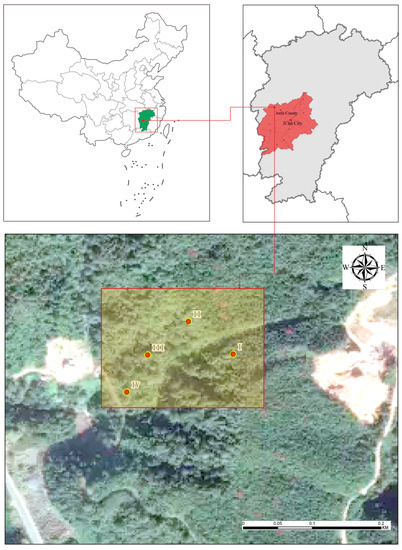
Figure 1
Open AccessArticle
Tactical Forwarder Planning: A Data-Driven Approach for Timber Forwarding
by
, , , , and
Forests 2023, 14(9), 1782; https://doi.org/10.3390/f14091782 (registering DOI) - 01 Sep 2023
Abstract
Tactical planning in timber harvesting involves aspects related to forest macro-planning and, particularly, the allocation of resources and sequencing of activities, all of which affect the allocation of timber in forest yards and roads and the productivity of forest machines. Data-driven approaches encourage
[...] Read more.
Tactical planning in timber harvesting involves aspects related to forest macro-planning and, particularly, the allocation of resources and sequencing of activities, all of which affect the allocation of timber in forest yards and roads and the productivity of forest machines. Data-driven approaches encourage the use of information obtained from data to enhance decision-making efficiency and support the development of short-term strategies. Therefore, our investigation was intended to determine whether a data-driven approach can generate sufficient input for modeling forwarder productivity in timber forwarding in Pinus and Eucalyptus planted forests, to support tactical planning. We utilized 3812 instances of raw data that were generated over a 36-month period. The data were collected from 23 loggers who operated in Pinus and Eucalyptus planted forests. We applied 22 regression algorithms that applied a supervised learning method from an experimental machine learning approach to the data instances. We evaluated the fitted models using three performance metrics. Out of the tested algorithms, the default mode of light gradient boosting produced a root mean squared error of 14.80 m3 h−1, a mean absolute error of 2.70, and a coefficient of determination of 0.77. Therefore, data-driven methods adequately support forwarder productivity modeling in timber forwarding in planted forests and help forest managers with tactical planning.
Full article
(This article belongs to the Section Forest Operations and Engineering)
►▼
Show Figures
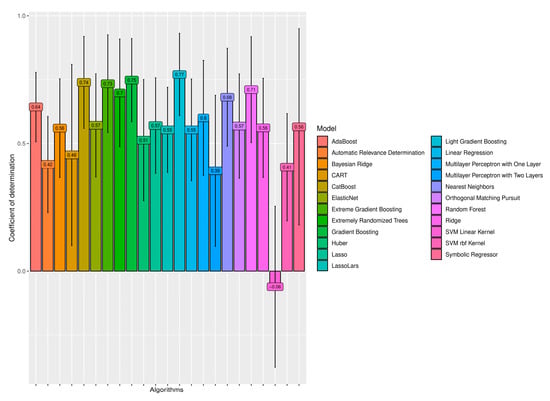
Figure 1
Open AccessArticle
Effect of Tannic Acid on the Corrosion Behavior of W18Cr4V in a Simulated Wood Environment and Its Inhibition Mechanism
Forests 2023, 14(9), 1781; https://doi.org/10.3390/f14091781 (registering DOI) - 31 Aug 2023
Abstract
This study explores the effect of tannic acid on the corrosion of woodworking tool material W18Cr4V in a simulated wood environment. The weight loss method, potentiodynamic polarization, and electrochemical impedance spectroscopy were used to study the corrosion and the corrosion inhibition process of
[...] Read more.
This study explores the effect of tannic acid on the corrosion of woodworking tool material W18Cr4V in a simulated wood environment. The weight loss method, potentiodynamic polarization, and electrochemical impedance spectroscopy were used to study the corrosion and the corrosion inhibition process of W18Cr4V in an environment of acetic acid solution with different concentrations of tannic acid. The results show that after continuous immersion for 20 h, low concentrations (1 wt% and 3 wt%) of tannic acid promoted the corrosion of W18Cr4V, while high concentrations (5 wt% and above) of tannic acid had a significant anti-corrosion effect, with a corrosion inhibition efficiency of about 64% for 10 wt% tannic acid. Scanning electron microscopy, energy-dispersive X-ray spectroscopy, and X-ray photoelectron spectroscopy were used to further verify and elucidate the inhibition mechanism. It was found that tannic acid can form a dense and effective corrosion inhibition film composed of iron–tannin complexes on the surface of W18Cr4V. This study not only provides a new perspective on understanding the corrosion effect of tannic acid on woodworking tools but also offers new insights for developing effective bio-corrosion protection strategies.
Full article
(This article belongs to the Special Issue Advances in Technology and Solutions for Wood Processing)
►▼
Show Figures
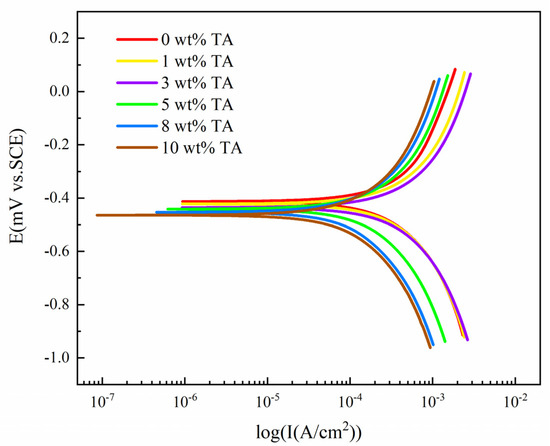
Figure 1
Open AccessArticle
An Alternative Method for Dating of Wildfire Occurrence from Tree-Ring Cores: A Case Study in Northeastern Asia
by
, , , , , , , , and
Forests 2023, 14(9), 1780; https://doi.org/10.3390/f14091780 - 31 Aug 2023
Abstract
The tree-ring fire scar stands as a pivotal proxy for reconstructing historical wildfire occurrences, providing invaluable context for comprehending contemporary wildfire activities during the Anthropocene era. Precise identification of fire scars often necessitates sampling complete tree disks. Yet, stringent forest resource protection policies
[...] Read more.
The tree-ring fire scar stands as a pivotal proxy for reconstructing historical wildfire occurrences, providing invaluable context for comprehending contemporary wildfire activities during the Anthropocene era. Precise identification of fire scars often necessitates sampling complete tree disks. Yet, stringent forest resource protection policies limit such collection in certain regions, thus curtailing the application of tree-ring-based fire reconstruction. While current methods based on tree-ring cores can ascertain the age range of fire events, pinpointing the exact year remains challenging. In this study, we propose a novel approach for detecting fire occurrence years by recognizing abrupt shifts in the tree-ring geometric center (TRGC). This method entails extracting a minimum of three tree-ring cores from the uninjured side of the tree and in proximity to the fire scar. We validated this method’s efficacy using samples from Transbaikal of Russia, in northeastern Asia, where fire years have already been documented. Our results show that this method accurately identified the fire year in nine fire scars with a 67 percent probability of exact agreement with the actual fire year. It is noteworthy that this method particularly excels in cases of trees with a single fire scar. We recommend employing the traditional method of collecting tree-ring cores near the fire scar to establish the age range of the fire scar. Subsequently, within this determined range, we suggest detecting the shifts in the TRGC to accurately pinpoint the exact year of the fire scar.
Full article
(This article belongs to the Section Natural Hazards and Risk Management)
►▼
Show Figures
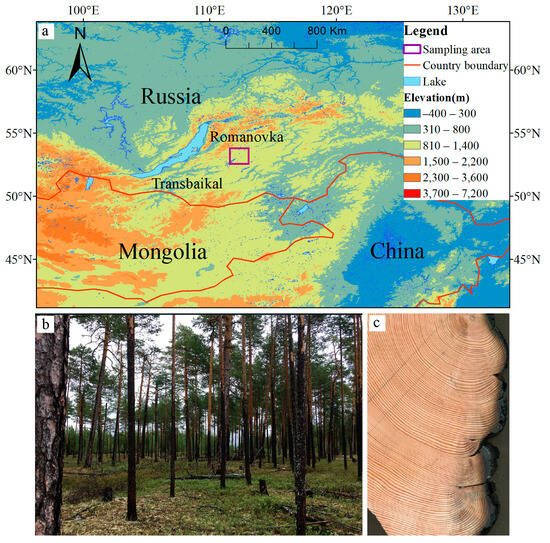
Figure 1
Open AccessArticle
Allometric Model of Crown Length for Pinus sylvestris L. Stands in South-Western Poland
by
and
Forests 2023, 14(9), 1779; https://doi.org/10.3390/f14091779 - 31 Aug 2023
Abstract
The growth of a tree depends on the size, shape, and functioning of the crown. The length of the crown is a somewhat subjective value because the base of the crown is often difficult to determine. The aim of this study was to
[...] Read more.
The growth of a tree depends on the size, shape, and functioning of the crown. The length of the crown is a somewhat subjective value because the base of the crown is often difficult to determine. The aim of this study was to develop an allometric model to calculate the crown length of Pinus sylvestris L., which might serve as an alternative to the current equations used especially for stands of variable density. The model used three predictive variables, i.e., diameter at breast height, tree height, and density. The developed crown length model showed high compatibility with empirical data within the studied stands differing in diameter at breast height, height, age, biosocial position, and, above all, density (SD = 1.786). The correlation coefficient between the empirical crown length for the stand (
(This article belongs to the Section Forest Ecology and Management)
►▼
Show Figures
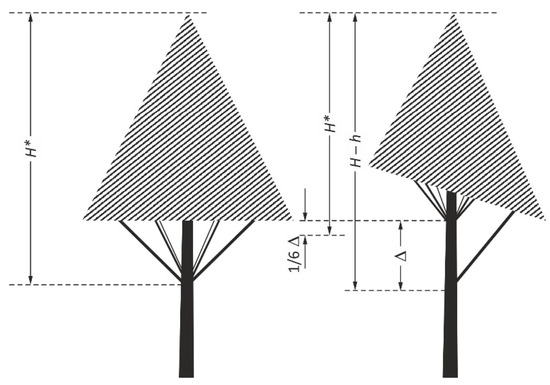
Figure 1
Open AccessArticle
Comparative Chloroplast Genomics Reveals a Unique Gene Inversion in Two Cordia Trees (Cordiaceae)
Forests 2023, 14(9), 1778; https://doi.org/10.3390/f14091778 (registering DOI) - 31 Aug 2023
Abstract
Cordiaceae is a family comprising more than 400 species in the order Boraginales. The classification of this family has undergone changes over time, transitioning between family and subfamily status. In the present study, the complete chloroplast (cp) genomes of Cordia monoica and Cordia
[...] Read more.
Cordiaceae is a family comprising more than 400 species in the order Boraginales. The classification of this family has undergone changes over time, transitioning between family and subfamily status. In the present study, the complete chloroplast (cp) genomes of Cordia monoica and Cordia sinensis were sequenced, and their cp genomes were then characterized, analyzed, and compared to those of closely related taxa. The lengths of the cp genomes of C. monoica and C. sinensis were 151,813 bp and 152,050 bp, respectively. Both genomes consisted of 114 genes, divided into 4 ribosomal RNA genes, 30 transfer RNA genes, and 80 protein-coding genes. We observed a unique gene inversion in the trnM-rbcL region of both Cordia species. The long repeats analysis revealed that both species’ chloroplast genomes contained forward and palindromic repeats. The simple sequence repeats (SSRs) analysis detected 155 microsatellites in each genome, with the majority being mononucleotide repeats (A/T). Phylogenetic analysis based on maximum likelihood and Bayesian analyses confirmed two major clades in the order Boraginales: clade I comprised Boraginaceae, while clade II included Cordiaceae, Ehretiaceae, and Heliotropiaceae. This study expands our knowledge of the evolutionary relationships across the order Boraginales and offers useful genetic resources.
Full article
(This article belongs to the Special Issue Genetic Variation and Adaptation of Forest Trees to Environmental Changes)
►▼
Show Figures
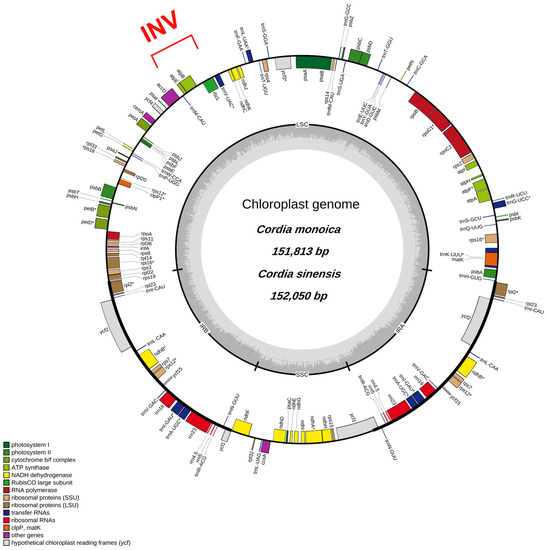
Figure 1
Open AccessArticle
The Effects of Homologous and Heterologous Grafting on the Growth of Gleditsia sinensis Scions
Forests 2023, 14(9), 1777; https://doi.org/10.3390/f14091777 - 31 Aug 2023
Abstract
Gleditsia sinensis Lam. (Fam. Leguminosae; Gen.: Gleditsia) has various uses, including for medicinal, edible, chemical, and material purposes, and is widely distributed in China. However, the extent of graft compatibility and its impact on growth when using different Gleditsia species as
[...] Read more.
Gleditsia sinensis Lam. (Fam. Leguminosae; Gen.: Gleditsia) has various uses, including for medicinal, edible, chemical, and material purposes, and is widely distributed in China. However, the extent of graft compatibility and its impact on growth when using different Gleditsia species as rootstocks for grafting G. sinensis scions is not yet clear. This study examined homologous and heterologous grafting between different Gleditsia species, measuring the survival rate, morphology, photosynthesis, physiology, and hormones of the grafted plants. The results showed that G. sinensis and other Gleditsia seedlings have survival rates of over 86%. The more distant the genetic relationship between species, the lower the grafting survival rate. The grafting of fast-growing G. fera as a rootstock increased the accumulation of photosynthetic products in the grafted plants, while the grafting of slow-growing G. microphylla as a rootstock slowed down the growth rate of the longitudinal extension of the leaves of the grafted plants. Heterografted rootstocks increased the contents of IPA, PP333, ACC, and DZ but decreased the levels of GA4, iP, and SA hormones. Some hormone levels that can be highly expressed in seedlings were used as rootstocks, and the corresponding hormone levels in the grafted seedlings were still highly expressed. This study lays a material and theoretical basis for the development of new resources for the breeding and rootstock selection of G. sinensis.
Full article
(This article belongs to the Special Issue Advances in Tree Germplasm Innovation and High-Efficiency Propagation)
►▼
Show Figures
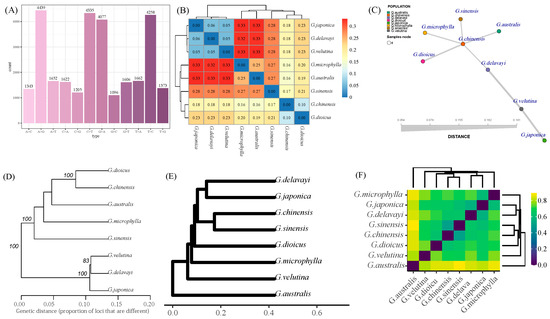
Figure 1
Open AccessArticle
Forest Cover Change Monitoring Using Sub-Pixel Mapping with Edge-Matching Correction
Forests 2023, 14(9), 1776; https://doi.org/10.3390/f14091776 - 31 Aug 2023
Abstract
Sentinel-2 serves as a crucial data source for monitoring forest cover change. In this study, a sub-pixel mapping of forest cover is performed on Sentinel-2 images, downscaling the spatial resolution of the positioned results to 2.5 m, enabling sub-pixel-level forest cover monitoring. A
[...] Read more.
Sentinel-2 serves as a crucial data source for monitoring forest cover change. In this study, a sub-pixel mapping of forest cover is performed on Sentinel-2 images, downscaling the spatial resolution of the positioned results to 2.5 m, enabling sub-pixel-level forest cover monitoring. A novel sub-pixel mapping with edge-matching correction is proposed on the basis of the Sentinel-2 images, combining edge-matching technology to extract the forest boundary of Jilin-1 images at sub-meter level as spatial constraint information for sub-pixel mapping. This approach enables accurate mapping of forest cover, surpassing traditional pixel-level monitoring in terms of accuracy and robustness. The corrected mapping method allows more spatial detail to be restored at forest boundaries, monitoring forest changes at a smaller scale, which is highly similar to actual forest boundaries on the surface. The overall accuracy of the modified sub-pixel mapping method reaches 93.15%, an improvement of 1.96% over the conventional Sub-pixel-pixel Spatial Attraction Model (SPSAM). Additionally, the kappa coefficient improved by 0.15 to reach 0.892 during the correction. In summary, this study introduces a new method of forest cover monitoring, enhancing the accuracy and efficiency of acquiring forest resource information. This approach provides a fresh perspective in the field of forest cover monitoring, especially for monitoring small deforestation and forest degradation activities.
Full article
(This article belongs to the Topic Remote Sensing and Visualization Methods: Monitoring, Modeling, Simulations and Interaction of Forest Resource)
►▼
Show Figures
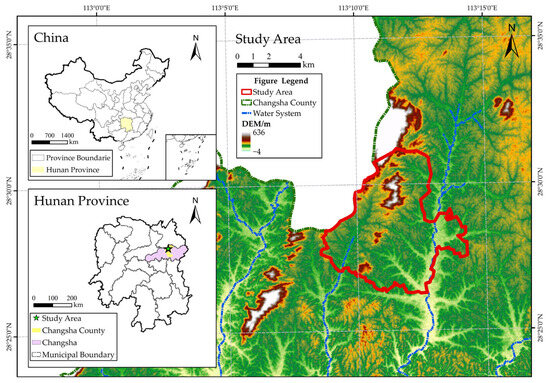
Figure 1
Open AccessArticle
Evaluation of the Deterioration State of Historical Palm Leaf Manuscripts from Burma
Forests 2023, 14(9), 1775; https://doi.org/10.3390/f14091775 - 31 Aug 2023
Abstract
Palm leaf manuscripts were a prevalent literary medium from South Asia and Southeast Asia prior to the widespread use of paper. This study focuses on the analysis of historical palm leaf manuscripts from South and Southeast Asia. Sample palm leaf manuscripts from Burma
[...] Read more.
Palm leaf manuscripts were a prevalent literary medium from South Asia and Southeast Asia prior to the widespread use of paper. This study focuses on the analysis of historical palm leaf manuscripts from South and Southeast Asia. Sample palm leaf manuscripts from Burma were used as a case study; simulated palm leaf manuscripts were also created as a reference for comparison. The anatomy, chemical composition, and mechanical properties of the manuscripts were analyzed to find various forms of deterioration, including damage, fractures, pollution, acidification, and microbial deterioration. Specifically, the S1–S3 layers of the cell walls exhibited complete cracking, and the S2 layer showed numerous circular or nearly circular cavities caused by microbial erosion, while the middle lamella remained intact. The severe degradation of polysaccharides and pectin, accompanied by an increase in the relative content of lignin, caused the historical manuscripts to become more brittle. Additionally, the tensile strengths of historical palm leaf manuscripts were markedly reduced; their longitudinal tensile strength was significantly greater than their transverse tensile strength. This study can contribute to a better understanding of the deterioration process of historical palm leaf manuscripts and provide valuable insights for their restoration and preservation.
Full article
(This article belongs to the Section Wood Science and Forest Products)
►▼
Show Figures
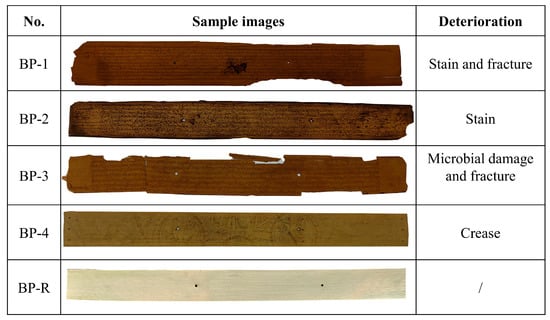
Figure 1
Open AccessArticle
Selection for Both Growth and Wood Properties in Chinese Fir Breeding Parents Based on a 6-Year Grafted Clone Test
Forests 2023, 14(9), 1774; https://doi.org/10.3390/f14091774 - 31 Aug 2023
Abstract
With the growing demand for high-quality timber, selection processes for both growth and wood properties are needed for multi-trait breeding programs in Chinese fir (Cunninghamia lanceolata (Lamb.) Hook.). The present study examined the variation and correlation of growth (tree height, diameter at
[...] Read more.
With the growing demand for high-quality timber, selection processes for both growth and wood properties are needed for multi-trait breeding programs in Chinese fir (Cunninghamia lanceolata (Lamb.) Hook.). The present study examined the variation and correlation of growth (tree height, diameter at breast height, stem volume, crown-width) and wood properties (wood basic density, hygroscopicity, and heart-wood ratio) traits of 201 Chinese fir breeding parents, aiming to select better parents for future multi-trait improvement. The results showed that significant differences (p < 0.01) regarding growth and wood property traits were observed among clones in an individual site and in a two-site joint analysis. The repeatability of the tested traits varied from 0.22 to 0.87. Strong and positive (p < 0.01) correlations were detected among the four growth traits, while wood basic density had a significant negative correlation (p < 0.01 or 0.05) with the growth traits. A set of parent clones was shortlisted with substantial realized gains (ranging from 4.59% to 83.77%) in growth and wood traits. It was suggested that these selected parents could be used to improve the growth and wood quality of Chinese fir.
Full article
(This article belongs to the Special Issue Long-Term Genetic Improvement and Molecular Breeding of Chinese Fir)
►▼
Show Figures
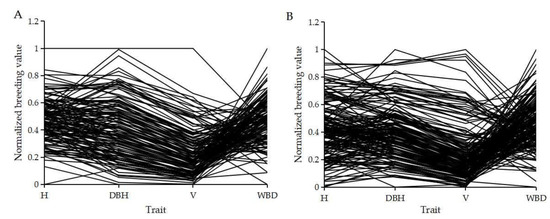
Figure 1
Open AccessArticle
Preparation of Teakwood Bending Components with Excellent Softening Properties by Vacuum Impregnation with Triethanolamine Compounding Solution
Forests 2023, 14(9), 1773; https://doi.org/10.3390/f14091773 - 31 Aug 2023
Abstract
To study the softening bending properties and mechanism of teakwood, it was extractively pretreated by using superheated steam, the triethanolamine compound was used as a softening solution, which was infiltrated into the wood by vacuum impregnation and synergistically softened through saturated steam to
[...] Read more.
To study the softening bending properties and mechanism of teakwood, it was extractively pretreated by using superheated steam, the triethanolamine compound was used as a softening solution, which was infiltrated into the wood by vacuum impregnation and synergistically softened through saturated steam to improve the bending properties of teakwood. Analysis by Fourier transform infrared spectroscopy (FTIR), Carbon 13 nuclear magnetic resonance (13C NMR), and X-ray photoelectron spectroscopy (XPS) showed that the synergistic softening treatment elevated the content of O and N elements in the softening solution and together with the C elements in the wood, formed C-NH2 and C-N bonds, which increased the molecular activity and improved the softening properties of teakwood. Scanning electron microscope (SEM) observations revealed that the outer conduits, cell walls, and fibrous tissue structures of the teakwood were stretched after softening and bending, and even microcracks of different degrees were formed between the cell walls. According to the load–deformation relationship of teakwood softening bending, the stress–strain relationship was theoretically derived and the bifold constitutive model of teakwood bending was constructed after fitting the constitutive relationship data, the integrated correlation coefficient R2 was 96.25%, which proved that the present model can better simulate the constitutive relationship of teakwood in bending.
Full article
(This article belongs to the Section Wood Science and Forest Products)
►▼
Show Figures
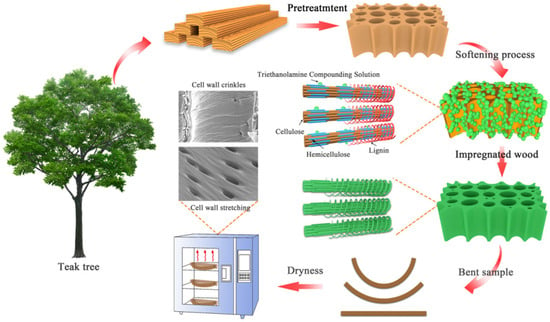
Figure 1
Open AccessArticle
Preparation of Superhydrophobic Wood Surfaces Modified Using MIL-88(Fe) via Solvothermal Method
Forests 2023, 14(9), 1772; https://doi.org/10.3390/f14091772 - 31 Aug 2023
Abstract
A superhydrophobic wood surface was produced by employing the solvothermal method to form shuttle-like, well-crystallized MIL-88(Fe) on the surface of wood and assembling a Octadecylphosphonic acid (OPA) reagent. The nanosized MIL-88(Fe) molecule caused the wood’s surface to take on a nano mastoid shape.
[...] Read more.
A superhydrophobic wood surface was produced by employing the solvothermal method to form shuttle-like, well-crystallized MIL-88(Fe) on the surface of wood and assembling a Octadecylphosphonic acid (OPA) reagent. The nanosized MIL-88(Fe) molecule caused the wood’s surface to take on a nano mastoid shape. In addition, MIL-88(Fe) provides metal sites to capture OPA molecules, preventing the long-chain alkane hydrophobic group from contacting the surface of the wood. They both make a considerable difference in the growth of a hydrophobic wood surface. The results of the experiment indicate that the water contact angle (WCA) increases with reactant concentration. The WCA of the samples prepared with 5.0 × 10−2 M FeCl3 was 140.57°. When the reactant concentration was 10.0 × 10−2 M, the greatest WCA = 153.69° reading was obtained. The research’s findings present a novel technique for producing superhydrophobic wood surfaces.
Full article
(This article belongs to the Special Issue Wood Treatments and Modification Technologies)
►▼
Show Figures

Figure 1
Open AccessArticle
Genome-Wide Identification and Expression Analysis of Salt Tolerance-Associated WRKY Family Genes in Cyclocarya paliurus
Forests 2023, 14(9), 1771; https://doi.org/10.3390/f14091771 - 31 Aug 2023
Abstract
WRKY proteins are key transcription factors involved in a range of physiological processes and environmental adaptations. Yet, little is known about the role WRKY genes play in Cyclocarya paliurus (Batal.) Iljinskaja (C. paliurus) a significant medicinal plant belonging to
[...] Read more.
WRKY proteins are key transcription factors involved in a range of physiological processes and environmental adaptations. Yet, little is known about the role WRKY genes play in Cyclocarya paliurus (Batal.) Iljinskaja (C. paliurus) a significant medicinal plant belonging to the Juglandaceae family. Leveraging the recently released whole-genome sequence of C. paliurus, we conducted an in-depth, genome-wide study on the expression of WRKY genes under environmental stresses. We identified 80 CpWRKY genes, classifying them into distinct groups and subgroups based on their structural and phylogenetic characteristics. Synteny analysis and phylogenetic comparison provided insights into the evolutionary traits of these genes. We further investigated the response of the WRKY gene family to salinity stress in combination with the following specific stressors: Methyl jasmonate (MeJA), sodium hydrosulfide (NaHS), and sodium nitroprusside (SNP), which induce the production of signaling molecules jasmonates (JA), hydrogen sulfide (H2S), and nitric oxide (NO), respectively. Our comprehensive analysis of CpWRKY gene expression patterns under various conditions revealed that combined treatments were more effective in inducing up-regulation of CpWRKY gene expression than individual treatments.
Full article
(This article belongs to the Special Issue Genomics of Growth Traits and Stress Acclimation in Forest Trees)
►▼
Show Figures
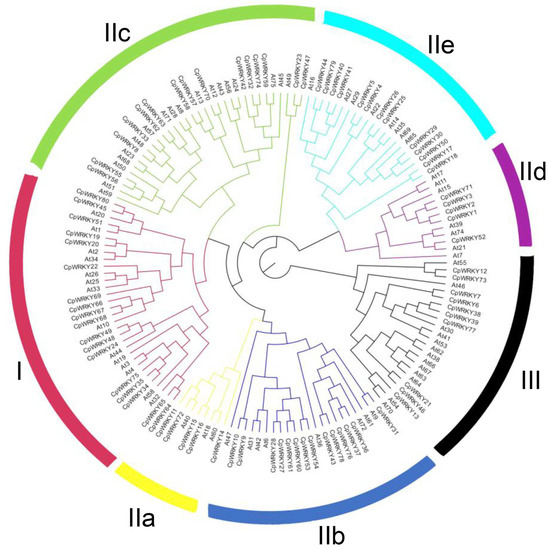
Figure 1
Open AccessArticle
Restorative Environment Characteristics of an Urban Forest Based on Big Data Analytics
Forests 2023, 14(9), 1770; https://doi.org/10.3390/f14091770 - 31 Aug 2023
Abstract
Since the COVID-19 pandemic, urban forests have become important restorative environmental spaces for which demand-customized management based on users’ experiences is needed. We collected 21,557 data points from blogs from January 2020 to December 2021. For data analysis, keyword frequency, term frequency–inverse document
[...] Read more.
Since the COVID-19 pandemic, urban forests have become important restorative environmental spaces for which demand-customized management based on users’ experiences is needed. We collected 21,557 data points from blogs from January 2020 to December 2021. For data analysis, keyword frequency, term frequency–inverse document frequency, and sentiment analyses were conducted using TEXTOM 4.0, and a semantic linkage network was established and analyzed using Gephi 0.92. In the analyses, the restorative environment components of “being away”, “fascination”, “extent”, and “compatibility” were derived from users’ experiences. Fascination, which stems from natural objects such as rocks, valleys, and trails, was derived the most frequently, and being away and compatibility, representing leisure activities such as climbing and walking, formed the largest cluster in cluster analysis. Sentiment analysis revealed a high positive word rate of 91.6%, with favorable feelings accounting for 87.5%, whereas the proportion of joy and interest (12.5%) was relatively low. In addition, this study showed that hard fascinations such as sports, entertainment, and education are required to improve the experience quality in urban forests as restorative environments. Hence, the necessity of local government policies and projects is emphasized.
Full article
(This article belongs to the Special Issue Forest, Trees, Human Health and Wellbeing)
►▼
Show Figures
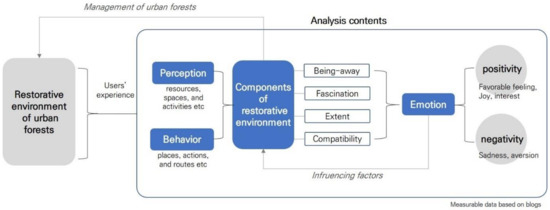
Figure 1
Open AccessArticle
Modeling Ecological Resilience of Alpine Forest under Climate Change in Western Sichuan
Forests 2023, 14(9), 1769; https://doi.org/10.3390/f14091769 - 31 Aug 2023
Abstract
The ecological resilience of forests is the ability to return to a stable state after being subjected to external disturbances, and it is among the critical indicators of forest status. Climate change has significant effects on forest ecological resilience and diversity. In this
[...] Read more.
The ecological resilience of forests is the ability to return to a stable state after being subjected to external disturbances, and it is among the critical indicators of forest status. Climate change has significant effects on forest ecological resilience and diversity. In this research, we selected Mao County as the study region, and employed the forest landscape model LANDIS-II to simulate the effect of different climate scenarios on the ecological resilience of alpine forests in western Sichuan during the next 300 years from the forest composition and structure perspective. The findings revealed that: (1) climate change will favor an increase in forest ecological resilience values in short simulations, but future climate scenarios will negatively impact the ecological resilience of forests as the simulation progresses through the middle and long term. (2) The rate of change of forest ecological resilience in the MTDF and SCF ecotones, which have a higher proportion of Fir (Abies fabri) and Spruce (Picea asperata), was greater than that in the rest of the ecotones in the short-term simulation. In contrast, it was the opposite in the medium-term simulation. The rate of change of forest ecological resilience was more significant in the long-term simulation in all four ecotones. (3) The high values of forest ecological resilience in the short- and medium-term simulations were primarily concentrated within the MTDF and SCF ecotones among the midwestern and northern parts of the study region. When the simulation proceeded to a later stage, the ecological resilience of the forests decreased significantly throughout the study region, with high values occurring only in some areas within the western parts of the study region. The research results can grasp the influence of future climate on the ecological resilience of high mountain forests within western Sichuan and provide an essential reference for the sustainable development of local forests.
Full article
(This article belongs to the Special Issue Aboveground and Belowground Interaction and Forest Carbon Cycling)
►▼
Show Figures
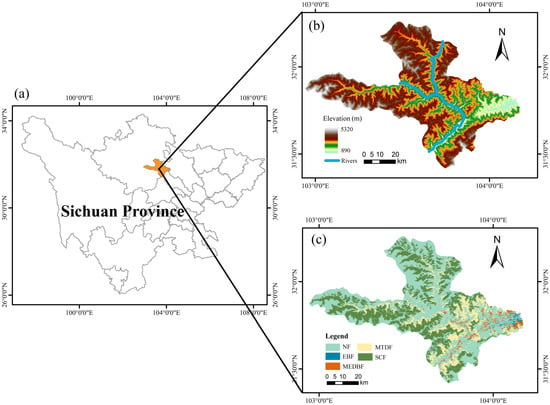
Figure 1
Open AccessArticle
Assessment of the Potential of Indirect Measurement for Sap Flow Using Environmental Factors and Artificial Intelligence Approach: A Case Study of Magnolia denudata in Shanghai Urban Green Spaces
Forests 2023, 14(9), 1768; https://doi.org/10.3390/f14091768 - 31 Aug 2023
Abstract
The measurement of plant sap flow has long been a traditional method for quantifying transpiration. However, conventional direct measurement methods are often costly and complex, thereby limiting the widespread application of tree sap flow monitoring techniques. The concept of a Virtual Measurement Instrument
[...] Read more.
The measurement of plant sap flow has long been a traditional method for quantifying transpiration. However, conventional direct measurement methods are often costly and complex, thereby limiting the widespread application of tree sap flow monitoring techniques. The concept of a Virtual Measurement Instrument (VMI) has emerged in response to this challenge by combining simple instruments with Artificial Intelligence (AI) algorithms to indirectly assess specific measurement objects. This study proposes a tree sap flow estimation method based on environmental factors and AI algorithms. Through the acquisition of environmental factor data and the integration of AI algorithms, we successfully achieved indirect measurement of tree sap flow. Accounting for the time lag response of the flow to environmental factors, we constructed the Magnolia denudata sap flow estimation model using the K-Nearest Neighbor (KNN), Random Forest (RF), Backpropagation Neural Network (BPNN), and Long Short-Term Memory network (LSTM) algorithms. The research results showed that the LSTM model demonstrated greater reliability in predicting sap flow velocity, with R2 of 0.957, MAE of 0.189, MSE of 0.059, and RMSE of 0.243. The validation of the target tree yielded an R2 of 0.821 and an error rate of only 4.89% when applying the model. In summary, this sap flow estimation method based on environmental factors and AI provides new insights and has practical value in the field of tree sap flow monitoring.
Full article
(This article belongs to the Special Issue Forest Hydrology under Climate Change)
►▼
Show Figures

Figure 1
Open AccessArticle
Habitat Distribution Pattern of Rare and Endangered Plant Magnolia wufengensis in China under Climate Change
Forests 2023, 14(9), 1767; https://doi.org/10.3390/f14091767 - 31 Aug 2023
Abstract
Magnolia wufengensis is a newly discovered rare and endangered species endemic to China. The primary objective of this study is to find the most suitable species distribution models (SDMs) by comparing the different SDMs to predict their habitat distribution for protection and introduction
[...] Read more.
Magnolia wufengensis is a newly discovered rare and endangered species endemic to China. The primary objective of this study is to find the most suitable species distribution models (SDMs) by comparing the different SDMs to predict their habitat distribution for protection and introduction in China under climate change. SDMs are important tools for studying species distribution patterns under climate change, and different SDMs have different simulation effects. Thus, to identify the potential habitat for M. wufengensis currently and in the 2050s (2041–2060) and 2070s (2061–2080) under different climate change scenarios (representative concentration pathways RCP2.6, RCP4.5, RCP6.0, and RCP8.5) in China, four SDMs, Maxent, GARP, Bioclim, and Domain, were first used to compare the predicted habitat and explore the dominant environmental factors. The four SDMs predicted that the potential habitats were mainly south of 40° N and east of 97° E in China, with a high distribution potential under current climate conditions. The area under the receiver operating characteristic (ROC) curve (AUC) (0.9479 ± 0.0080) was the highest, and the Kappa value (0.8113 ± 0.0228) of the consistency test and its performance in predicting the potential suitable habitat were the best in the Maxent model. The minimum temperature of the coldest month (−13.36–9.84 °C), mean temperature of the coldest quarter (−6.06–12.66 °C), annual mean temperature (≥4.49 °C), and elevation (0–2803.93 m), were the dominant factors. In the current climate scenario, areas of 46.60 × 104 km2 (4.85%), 122.82 × 104 km2 (12.79%), and 96.36 × 104 km2 (10.03%), which were mainly in central and southeastern China, were predicted to be potential suitable habitats of high, moderate, and low suitability, respectively. The predicted suitable habitats will significantly change by the 2050s (2040–2060) and 2070s (2060–2080), suggesting that M. wufengensis will increase in high-elevation areas and shift northeast with future climate change. The comparison of current and future suitable habitats revealed declines of approximately 4.53%–29.98% in highly suitable habitats and increases of approximately 6.45%–27.09% and 0.77%–21.86% in moderately and lowly suitable habitats, respectively. In summary, these results provide a theoretical basis for the response to climate change, protection, precise introduction, cultivation, and rational site selection of M. wufengensis in the future.
Full article
(This article belongs to the Special Issue Modeling Forest Response to Climate Change)
►▼
Show Figures

Figure 1
Open AccessArticle
Large-Scale and High-Accuracy Phenotyping of Populus simonii Leaves Using the Colony Counter and OpenCV
Forests 2023, 14(9), 1766; https://doi.org/10.3390/f14091766 - 31 Aug 2023
Abstract
Image-based morphometric technology is broadly applicable to generate large-scale phenomic datasets in ecological, genetic and morphological studies. However, little is known about the performance of image-based measuring methods on plant morphological characters. In this study, we presented an automatic image-based workflow to obtain
[...] Read more.
Image-based morphometric technology is broadly applicable to generate large-scale phenomic datasets in ecological, genetic and morphological studies. However, little is known about the performance of image-based measuring methods on plant morphological characters. In this study, we presented an automatic image-based workflow to obtain the accurate estimations for basic leaf characteristics (e.g., ratio of length/width, length, width, and area) from a hundred Populus simonii pictures, which were captured on Colony counter Scan1200. The image-based workflow was implemented with Python and OpenCV, and subdivided into three parts, including image pre-processing, image segmentation and object contour detection. Six image segmentation methods, including Chan-Vese, Iterative threshold, K-Mean, Mean, OSTU, and Watershed, differed in the running time, noise sensitivity and accuracy. The image-based estimates and measured values for leaf morphological traits had a strong correlation coefficient (r2 > 0.9736), and their residual errors followed a Gaussian distribution with a mean of almost zero. Iterative threshold, K-Mean, OSTU, and Watershed overperformed the other two methods in terms of efficiency and accuracy. This study highlights the high-quality and high-throughput of autonomous image-based phenotyping and offers a guiding clue for the practical use of suitable image-based technologies in biological and ecological research.
Full article
(This article belongs to the Section Forest Ecology and Management)
►▼
Show Figures
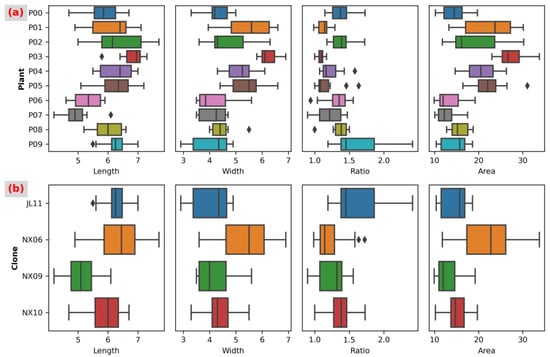
Figure 1

Journal Menu
► ▼ Journal Menu-
- Forests Home
- Aims & Scope
- Editorial Board
- Reviewer Board
- Topical Advisory Panel
- Instructions for Authors
- Special Issues
- Topics
- Sections & Collections
- Article Processing Charge
- Indexing & Archiving
- Editor’s Choice Articles
- Most Cited & Viewed
- Journal Statistics
- Journal History
- Journal Awards
- Editorial Office
Journal Browser
► ▼ Journal BrowserHighly Accessed Articles
Latest Books
E-Mail Alert
News
Topics
Topic in
Agronomy, Forests, Remote Sensing, Resources, Sustainability
Sustainability in Agri-Food and Forestry Ecosystems
Topic Editors: José Aranha, Mario CunhaDeadline: 25 September 2023
Topic in
Forests, Microorganisms, Sustainability
Climate and Substrate Control on Decomposition across Temperate and Tropical Forests
Topic Editors: Xiaoming Zou, Honghua RuanDeadline: 1 November 2023
Topic in
Diversity, Forests, IJPB, Land, Plants
Forest Ecosystem Restoration
Topic Editors: Dominick A. DellaSala, Lin Qi, Wangming ZhouDeadline: 15 November 2023
Topic in
Foods, Forests, IJERPH, Sustainability, Urban Science
Nature Therapy: The Physiological Effects of Nature on Humans
Topic Editors: Harumi Ikei, Hyunju Jo, Yoshifumi MiyazakiDeadline: 25 December 2023

Conferences
Special Issues
Special Issue in
Forests
Innovative Use of Timber and Wood-Based Composites: Applications, Design and Sustainability
Guest Editor: Alain CloutierDeadline: 5 September 2023
Special Issue in
Forests
Soil Biology and Biochemistry of Forests
Guest Editors: Mojtaba Zeraatpisheh, Weixin Zhang, Esmaeil Bakhshandeh, Alireza NaqinezhadDeadline: 15 September 2023
Special Issue in
Forests
Soil and Plant Restoration after Wildfire
Guest Editors: Demetrio Antonio Zema, Manuel Esteban Lucas-BorjaDeadline: 25 September 2023
Special Issue in
Forests
Dendrochemistry: Tools for Evaluating Variations in Past and Present Forest Environments
Guest Editor: Paul R SheppardDeadline: 20 October 2023
Topical Collections
Topical Collection in
Forests
Forests Carbon Fluxes and Sequestration
Collection Editor: Mark Harmon
Topical Collection in
Forests
Sustainable Forest Management: Past, Present, Future
Collection Editor: Heli Peltola
Topical Collection in
Forests
Reviews and Meta-Analyses in Forest Meteorology and Climate Change
Collection Editors: Riccardo Marzuoli, Giacomo Alessandro Gerosa
Topical Collection in
Forests
Forest Sustainable Management in Europe
Collection Editor: Ignacio Diaz-Maroto



